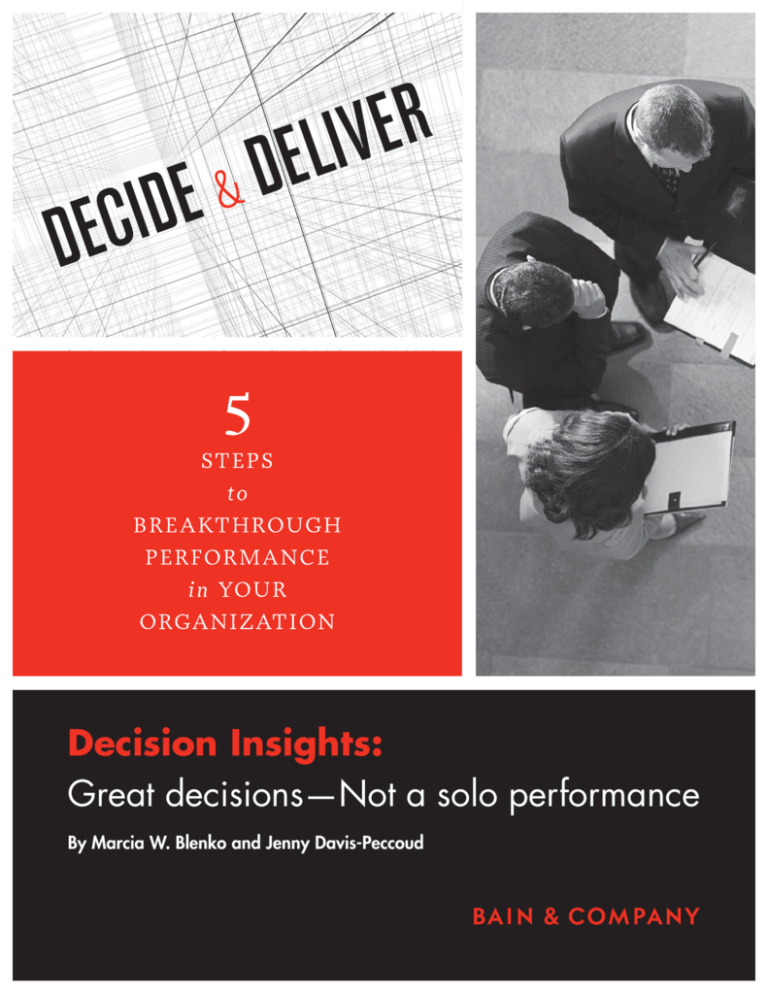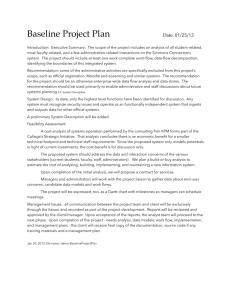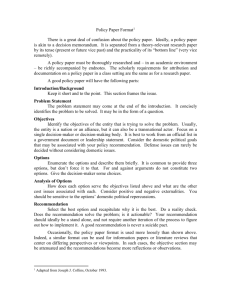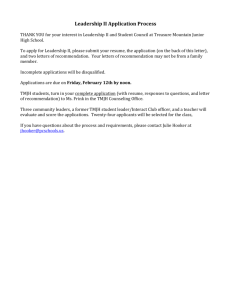
Decision Insights:
Great decisions—Not a solo performance
By Marcia W. Blenko and Jenny Davis-Peccoud
Marcia W. Blenko is a partner with Bain & Company and leads the firm’s Global
Organization practice. Jenny Davis-Peccoud is a practice area senior director for
Bain’s Global Organization practice.
Copyright © 2011 Bain & Company, Inc. All rights reserved.
Content: Global Editorial
Layout: Global Design
Great decisions—Not a solo performance
A few years ago, Marcia Blenko and Bain colleague Paul Rogers wrote an article in Harvard
Business Review called “Who Has the ‘D’?” Its central point: companies that are best at getting
things done specify who is responsible for every role in major decisions. Identifying and assigning
the key roles—Recommend, Agree, Perform, Input and, of course, Decide—cuts through all the
frustrating debates about (for instance) whether finance or a business unit should determine investment
levels, and whether marketing or engineering has the final say on a product’s features. The article
introduced a decision-rights tool we call RAPID®, which encapsulates all the roles in an easy-toremember acronym.
But perhaps we should have called the article “Who Has the ‘R’?” or “Who Has the ‘I’?” The
reason is that many companies take the original title too literally: they pay close attention to the
Decide role but too little attention to the others. As a result, their decision-and-execution processes
continue to hit bumps and barriers.
In this article we will try to redress the balance. We’ll look at each of the four supporting roles in
detail—what it is, what can go wrong and how to make things right.
The Recommend role
What it is. The R role typically involves 80 percent
of the work in a decision. The recommender
gathers relevant input and proposes a course of
action—sometimes alternative courses, complete
with pros and cons. Rs are the quarterbacks of
the decision process, coordinating the other roles
so that the decision maker’s choices are as clear,
simple and timely as possible. If they do their
job correctly, R’s will usually see their recommendations accepted by the D.
Getting the R right. Some organizations fail to
identify an R, thus forestalling a decision. When
one mining company, for example, was expanding
into a new region, corporate headquarters was
pushing to create an external relations organization
to support the new mine. Headquarters assumed
the regional vice president (RVP) would develop
a recommendation for the new structure. The
RVP expected headquarters to do it—after all,
it was their idea. The upshot: a big delay, until
the responsible executives eventually clarified
the R role.
Other organizations have too many recommenders. A media company we worked with
gave all of its editorial units an R on content,
which led to recurrent bottlenecks. It solved
the problem when it assigned one person to
integrate the inputs, set priorities and recommend tradeoffs. Even two Rs is too many. If
a business unit prepares a full-scale case recommending an acquisition while finance
prepares a recommendation against it, the
CEO will have to get to the bottom of both
views, and the decision will take longer than
it should.
To succeed, a company needs to specify the right
recommender for each key decision and ensure
that those individuals set decisions up for success.
R’s can start by sitting down with decision makers
to establish the parameters for the decision, the
form of the recommendation and the level of
rigor required. They can then clarify decision roles
and processes and map out a series of meetings
to gather the necessary input and signoffs. A
large technology company tries to capture these
best practices by arming every R with a checklist
of issues to consider, such as “Who should be
consulted to develop a complete recommendation?”
and “What is the right tradeoff between rigor
and speed for the recommendation?”
1
Great decisions—Not a solo performance
R is for Recommend
Key responsibilities
Skills and
character traits required
• Establish criteria and
required facts upfront
• Effective process
management
• Gather inputs
• Compelling
presentation skills
• Synthesize analysis
• Develop the
recommendation
• Good listening skills
• The ability to assemble
multiple viewpoints,
do logical analysis,
and make tradeoffs
• Trusted by the
decision maker
• Trusted by those
offering input
The Input role
What it is. People who offer input into a recommendation provide necessary information and
points of view. They help the recommender assess
whatever tradeoffs the decision may require. When
decisions are based primarily on analytics, people
in the I role provide the statistics and interpretations. Another I job is helping to think through
the implications of the decision, such as risks and
implementation challenges. Note, however, that
the I role is strictly advisory. Recommenders should
consider all input, but they don’t have to reflect
every point of view in the final recommendation.
Getting the I right. Ideally, the I group includes
everyone with relevant data, expertise or experience.
It should also include people who will be responsible for implementation, along with individuals
in parts of the organization affected by the decision.
Including these folks ensures that downstream
issues are considered, thus improving decision
quality and speeding buy-in. Serving as an I is
a big responsibility, and people in most highperforming organizations earn the right to
influence a decision by providing credible, highquality analytics and logic.
2
What can go wrong? Companies with inclusive
cultures often put too many people in an I role.
Dozens of unnecessary people in meetings clog
the process without improving decision quality.
And sometimes senior executives get involved
in topics that are best delegated. A consumer
products company we’re familiar with developed
a process to ensure that top leaders focused only
on major innovations. That was a wise move, but
unfortunately the company never spelled out which
decisions required their input. Soon the executives
found themselves arguing about matters such
as the height of the letters on product packages
rather than focusing on more important issues.
Other companies, however, don’t have enough
people in an I role and don’t get the specific
input they need. At a pharmaceutical company,
the drug-development decision process included
input relating to scientific and medical factors
but didn’t include sufficient input about payers’
willingness to cover the drug. As a result, the
company found itself investing in pharmaceuticals
that insurers were unlikely to pay for.
Best-practice companies not only define the right
Input roles; they also ensure that the designated
individuals can provide high-quality input on a
timely basis. A retailer, for instance, realized it
needed better input into decisions regarding what
products to stock and at what price points. So
the company created a set of standard templates
that allowed assistant brand managers to provide
the necessary analysis. That helped their supervisors, the brand managers, to make better
decisions and to make them faster.
I is for Input
Key responsibilities
• Provide input based
on data, experience
or position
• Ensure input is clearly
heard—bring high
quality analytics and
logic to bear and use
influence appropriately
Skills and
character traits required
• Access to data,
strong analytic skills
• Ability to provide
input in clear fashion,
e.g., not too detailed,
with relevant insights
clearly highlighted
• Ability to influence—
make sure people under
stand importance of input
• Willingness to argue
points firmly but accept
the outcome if final
decision differs
Great decisions—Not a solo performance
The Agree role
What it is. Unlike the I, the A is a form of input
that can’t be ignored. If the person holding an
A doesn’t agree, the recommendation must be
modified. The classic example of an A is a legal
or regulatory signoff, but in fact, many situations
lend themselves to A-type approval. A safety executive may need to sign off on a change in work
processes. A brand manager may have to agree
that a given decision won’t hurt the brand. Risk
management and finance functions often play
an A role to ensure that decisions fit the company’s
overall risk profile and budget constraints.
Getting the A right. Since too many people in
the A role creates gridlock—everyone can say no,
no one can say yes—top-performing companies
set a high bar for who should have an A. Many
decisions require no A at all. Others may need
only one or two. Agreement should always be
part of developing the recommendation—that
is, it should come before the decision, not after it.
Ideally, the recommender and the A work things out
between themselves, with the R amending the
proposal until the A is satisfied and the A providing constructive suggestions for creating a
feasible proposal.
It’s important to specify not just the A role but
the scope to which the A applies. At a medical device
company, the group responsible for regulatory
compliance had to sign off on the company’s marketing brochures. Regulatory managers reached
the point where they were exercising their A on
every aspect of the brochures, including the colors.
That made little sense, and it meant that every
brochure took too long to produce. When the company reassigned decision rights, it gave regulatory
an A role only on the text of a brochure to be
sure it was compliant with federal regulations.
Companies run into other sorts of A-related difficulties as well. Some recommendations may be
missing an essential A—and when the absence
is discovered, the decision has to be revisited.
Some people in the A role may wait for the decision
rather than weighing in on the recommendation;
when they finally slap down their veto card, they
undermine the decision maker’s authority and
cause further delay. Occasionally a company will
assign an A to a senior executive just because that
individual “should have a chance to weigh in.”
But that confuses the I role with the A.
Leading companies typically reduce the need for
constant signoffs by providing guidelines to their
businesses. Only if a decision goes outside the
guidelines does it require an approval from someone in an A role. Take a retail bank that for years
had run a cumbersome process to create direct
mail campaigns. Every mailing required approvals
from Finance (on the financial assumptions) and
Risk (on the mailing’s loss rate projections). Even
identical campaigns required a reexamination
of these assumptions and projections. The company saved a great deal of time and frustration
when it began providing guidelines for the
mailings. Now, marketing managers could make
their own decisions about mailings as long as they
stayed with the guidelines. Mailings outside of
the guidelines, such as a new offer or a mailing
to a new population, continued to require scrutiny
and approval by Finance and Risk.
There are times, of course, when a recommender
feels that the A is constraining the recommendation
too much and proceeds with the recommendation,
highlighting the A’s concerns. A telecommunications company, for instance, decided to launch
A is for Agree
Key responsibilities
Skills and
character traits required
• Sign off on key
recommendations to
ensure consistency with
company policies or
regulatory compliance
• Expertise and broad
view of relevant field,
e.g., legal requirements
or brand consistency
• Work with
recommender to
achieve mutually
satisfactory proposal
• Creativity and
openness to working
with recommenders
to find alternative
feasible solutions
• Negotiating abilities
• Discipline to focus
only on content within
scope of their A
3
Great decisions—Not a solo performance
a worldwide standard for contracts for select global
customers. But every local legal office in the
company assumed it had an A and effectively
blocked the decision. To break through, the company acknowledged the concerns but said that
the decision might go forward anyway. In effect,
the decision maker was prepared to take the
risks that the local legal offices had flagged.
When a company begins to specify decision roles,
many people who thought they had A responsibilities will be redefined into the I role. This may
feel like a demotion, so it’s important that everyone
understand both the merits of an A role and the
importance of an I role. Leaders need to reinforce
the significant benefits to decision making when
A and I roles are properly defined.
The Perform role
What it is. The P role defines who is accountable
for implementation. Best-practice companies
typically define P’s and gather input from them
early in the process. That lets the P’s flag implementation issues and encourages them to buy
in to the decision they will be executing. In
situations where the P is not known early, companies need to assign a P promptly once a
decision is made to ensure a timely transition
to the execution phase.
Getting the P right. Sometimes the P is never
defined, so a decision is never implemented. A
beverage company, for instance, decided to relocate
its IT center of excellence to a European city. But
no one was assigned the P, so no one began
looking for office space, figuring out how to
consolidate current IT operations with the new
center and so on. When a new CIO came on
board, she reopened the entire decision, which
meant that the company, in effect, had to make
the same decision twice.
Once a major decision is made and moved into
execution, of course, it will likely involve a set
of significant follow-on decisions. Implementation
4
P is for Perform
Key responsibilities
• Flag potential
implementation issues
early and ensure
decision is practical
• Execute decision
as intended
• Handle followon
decisions with rigor
Skills and
character traits required
• Excellent execution skills
• Ability to think
creatively through
roadblocks and come
up with solutions
• Ability to drive follow
on implementation
decisions at pace
• Practical outlook
• Good team player;
willing to execute even
if he or she doesn’t
agree with decision
teams need to apply the same rigor and RAPIDstyle analysis to these execution-related decisions
that they applied to the original one.
Decisions: A team sport
Specifying the individual who is responsible for
a major decision—assigning the D—is obviously
critical to good decision making. But it is less
than half the story. D’s can’t do their job without
great recommendations, insightful input and
the right signoffs. A robust recommendation
with the right input, cleared with folks who
have to agree, makes for a fast, high-quality
decision. And a decision obviously has no effect
unless someone—the P—is accountable for
executing it.
Companies that are best at decisions turn in better
financial performance, and it’s not hard to see why.
People know their roles. Decisions move smoothly
from recommendation to execution. The organization hums. Assigning all these roles, training
people to understand their responsibilities and
following through to ensure appropriate behaviors
all require a concerted effort. But they hold the
key to high performance.
Bain’s business is helping make companies more valuable.
Founded in 1973 on the principle that consultants must measure their success in terms
of their clients’ financial results, Bain works with top management teams to beat competitors
and generate substantial, lasting financial impact. Our clients have historically outperformed
the stock market by 4:1.
Who we work with
Our clients are typically bold, ambitious business leaders. They have the talent, the will
and the open-mindedness required to succeed. They are not satisfied with the status quo.
What we do
We help companies find where to make their money, make more of it faster and sustain
its growth longer. We help management make the big decisions: on strategy, operations,
technology, mergers and acquisitions and organization. Where appropriate, we work with
them to make it happen.
How we do it
We realize that helping an organization change requires more than just a recommendation.
So we try to put ourselves in our clients’ shoes and focus on practical actions.
w w w. b a i n . c o m






